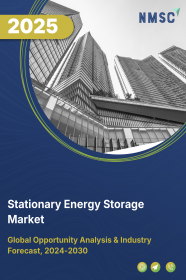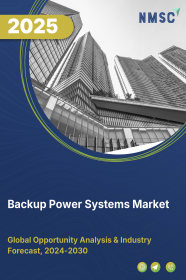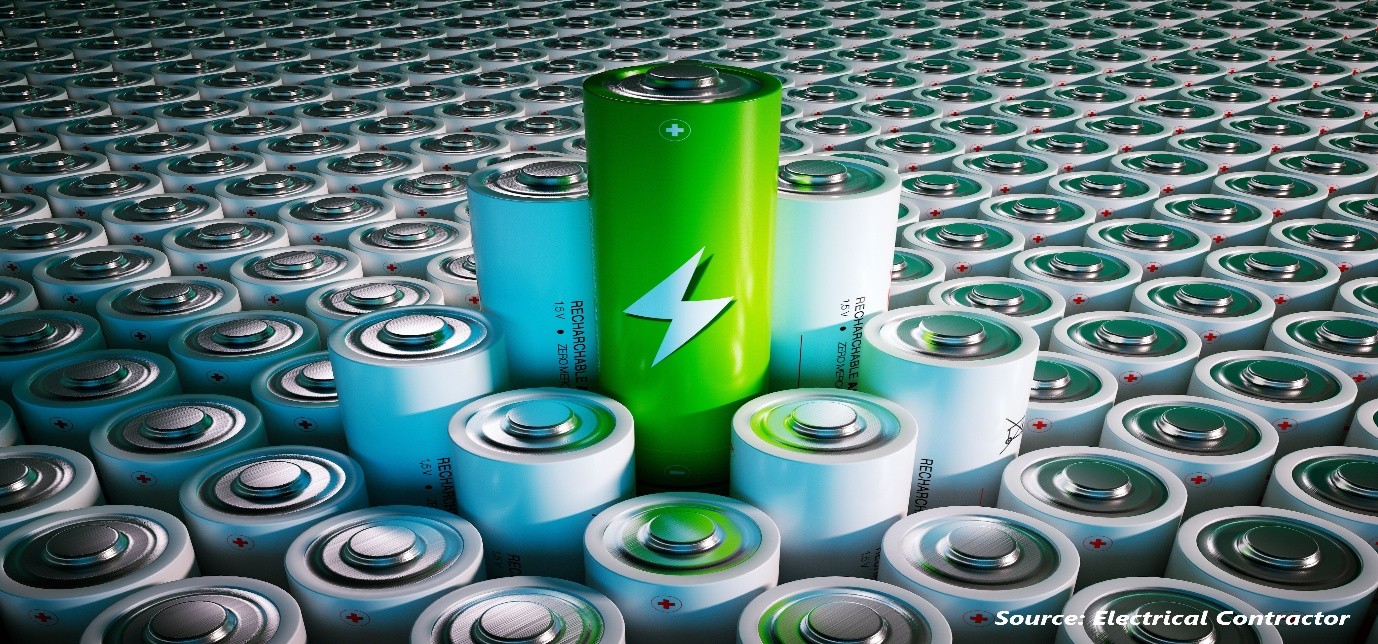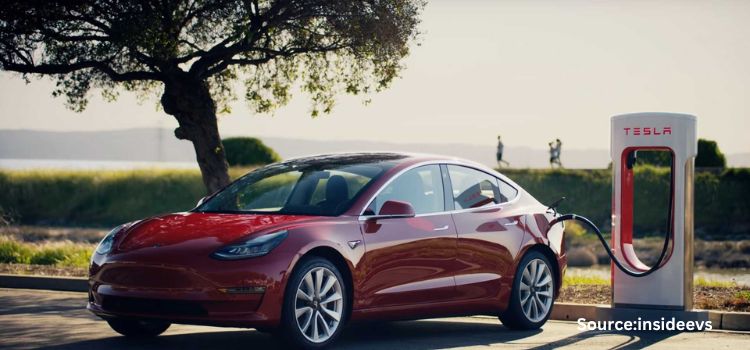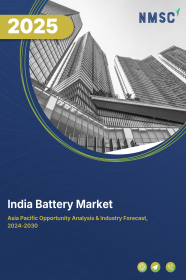
India Battery Market by Type (Stationary, and Motive), By Battery Type (Primary Batteries (Non-rechargeable), and Secondary Batteries (Rechargeable)), By Voltage Type (Low Voltage Batteries (1V - 12V), Medium Voltage Batteries (24V - 100V), High Voltage Batteries (200V - 1000V)), By Power Capacity (Low Capacity Batteries (Up to 1,000 mAh), and Others), and Others) and by By Application (Residential, Industrial and Commercial) – Opportunity Analysis and Industry Forecast 2023-2030
Industry: Energy & Power | Publish Date: 05-Feb-2025 | No of Pages: 167 | No. of Tables: 129 | No. of Figures: 74 | Format: PDF | Report Code : EP711
US Tariff Impact on India Battery Market
Trump Tariffs Are Reshaping Global Business
Market Definition
India Battery Market was valued at USD 6.31 billion in 2022, and is predicted to reach USD 20.04 billion by 2030, with a CAGR of 15.5% from 2023 to 2030.
A battery operates as a mechanism that stores energy and later releases it by transforming chemical energy into electrical energy. Typically, batteries produce electricity by harnessing one or more electrochemical cells. Batteries can be categorized into two distinct types such as primary batteries and secondary batteries. Primary batteries, also known as non-rechargeable batteries, offer a straightforward and convenient energy supply for various portable electronic and electrical devices, including cameras, watches, toys, lights, radios, and more. In contrast, secondary batteries, often referred to as rechargeable batteries, possess the capability to be recharged electrically once they've been depleted. These energy storage solutions have evolved into indispensable sources of power in our daily routines.
The progress of cutting-edge technologies, encompassing smartphones, tablets, laptops, solar energy systems, and electric vehicles (EVs), has ushered in the era of robust batteries capable of prolonged endurance and providing essential energy requirements.
India's Dominant Battery Market Share Driven by Booming Demand for Consumer Electronics
India holds major share of the battery market owing to presence of large population that generates high demand for consumer electronics, such as smartphones, laptops, handheld gaming devices, digital cameras, and more. Such electronic devices depend on rechargeable batteries, such as lithium-ion or alkaline cells. Thus, high sales of consumer electronics are increasing the demand for batteries in the country. For instance, in 2021, the total volume of smartphone shipments across India was around 160.7 million. Moreover, global smartphone brands such as Xiaomi and Samsung are investing heavily in India and establishing smartphone manufacturing plants in the country, which, in turn, is expected to drive the battery market. For instance, in February 2021, Xiaomi announced that it aims to establish three new mobile manufacturing plants in India.
Strategic Regional Auto Manufacturers and Government Initiatives Propel India's Electric Vehicle Market Growth
The factors such as presence of regional automobile manufacturers such as Tata Motors, Mahindra & Mahindra, Maruti Suzuki and several initiatives undertaken by the government of India to increase the adoption of EVs in the country are driving the battery market. For instance, in October 2021, Tata Motors launched a new electric hatchback in India named Tiago EV. Tiago EV uses a liquid cooled lithium-ion battery to operate its electric motor. Moreover, in August 2022, Mahindra & Mahindra announced its upcoming electric vehicle portfolio of five electric vehicle, including SUVs based on its EV platform Inglo, to cater to the fast-growing EV industry in India. Furthermore, in February 2022, the Ministry of Power announced that the government of India is undertaking several initiatives to expand EV charging infrastructure across the country. With such initiatives, the country aims to establish 22,000 EV charging stations in prominent cities and highways of India. Such factors are increasing the adoption of EVs in
India, which, in turn, is driving the growth of the battery market.
Concerns Regarding Battery Safety in India
Improper battery management presents significant risks to both human health and the environment. An ongoing issue involves the incorrect disposal of used batteries, leading to their buildup in landfills. Over time, these batteries break down, releasing harmful substances that seep into the soil and adversely affect surface water and groundwater, disrupting aquatic ecosystems. Elements like mercury, cadmium, lithium, and lead found in these batteries exacerbate this ecological imbalance, underscoring the urgency for proper battery disposal practices. Consequently, these concerns are anticipated to impede the progression of the battery market.
Introduction of Nano-Diamond Batteries (NDB) in Multiple Industries
The growing adoption of Nuclear Diamond Batteries (NDBs) across various sectors including automotive, aerospace, and electronics is positioned to create fresh avenues in India's battery market. NDBs represent a groundbreaking leap in energy generation and storage, fundamentally reshaping conventional battery concepts. These batteries showcase remarkable endurance by harnessing the energy derived from the radioactive decay of nuclear waste. The trajectory of India's battery market is being shaped by the compelling attributes of NDBs, which encompass their compact form, adaptability, cost-efficiency, and scalability across a wide array of applications, ranging from compact chipsets to expansive industrial setups. Functioning as advanced diamond-based alpha, beta, and neutron voltaic batteries, NDBs offer a consistent source of clean energy for a diverse spectrum of applications, surpassing the performance of traditional chemical batteries.
Competitive Landscape
The India battery industry includes several market players such as Toshiba Corporation, LG Energy Solution Ltd., Panasonic Corporation, Samsung SDI Co. Ltd, Exide Industries Ltd., Luminous Power Technologies, Eveready Industries India Ltd., Amara Raja Group, HBL Power Systems Ltd., Tata AutoComp Systems Ltd, Okaya Power Private Limited, Livguard, High Energy Batteries (India) Limited, BYD Company Ltd. and Su-kam.
Key Benefits
-
The India battery market report provides a quantitative analysis of the current market and estimations through 2023-2030 that assists in identifying the prevailing market opportunities to capitalize on.
-
The study comprises a deep dive analysis of the market trend including the current and future trends for depicting the prevalent investment pockets in the market.
-
The information related to key drivers, restraints, and opportunities and their impact on the market is provided in the report.
-
The competitive analysis of the market players along with their market share in the India battery market.
-
The SWOT analysis and Porter’s Five Forces model are elaborated in the study.
-
Value chain analysis in the market study provides a clear picture of the stakeholders’ roles.
India Battery Maeket Key Segemnts
By Type
-
Stationary
-
Motive
By Battery Type
-
Primary Batteries (Non-rechargeable)
-
Alkaline Batteries
-
Zinc-Carbon Batteries
-
Lithium-Thionyl Chloride Batteries
-
-
Secondary Batteries (Rechargeable)
-
Lead-Acid Batteries
-
Nickel-Cadmium (NiCd) Batteries
-
Nickel-Metal Hydride (NiMH) Batteries
-
Lithium-ion Batteries
-
Lithium Nickel Manganese Cobalt (LI-NMC)
-
Lithium Iron Phosphate (LFP)
-
Lithium Cobalt Oxide (LCO)
-
Lithium Titanate Oxide (LTO)
-
Lithium Manganese Oxide (LMO)
-
Lithium Nickel Cobalt Aluminum Oxide (NCA)
-
-
Other Secondary Batteries
-
By Voltage Type
-
Low Voltage Batteries (1V - 12V)
-
Medium Voltage Batteries (24V - 100V)
-
High Voltage Batteries (200V - 1000V)
By Power Capacity
-
Low Capacity Batteries (Up to 1,000 mAh)
-
Medium Capacity Batteries (1,000 mAh to 10,000 mAh)
-
High Capacity Batteries (10,000 mAh to 100,000 mAh)
-
Ultra High Capacity Batteries (More than 100,000 mAh)
By Self-Discharge Rate
-
Low Self-Discharge Rate Batteries
-
Medium Self-Discharge Rate Batteries
-
High Self-Discharge Rate Batteries
By Application
-
Residential
-
Industrial
-
Automotive
-
Medical
-
Telecom & IT
-
Consumer Electronics
-
Power & Utility
-
Aerospace & Defense
-
Marine
-
Other Industries
-
-
Commercial
Key Market Players
-
Toshiba Corporation
-
LG Energy Solution Ltd.
-
Panasonic Corporation
-
Samsung SDI Co. Ltd
-
Exide Industries Ltd.
-
Luminous Power Technologies
-
Eveready Industries India Ltd.
-
Amara Raja Group
-
HBL Power Systems Ltd.
-
Tata AutoComp Systems Ltd
-
Okaya Power Private Limited
-
Livguard
-
High Energy Batteries (India) Limited
-
BYD Company Ltd.
-
Su-kam
REPORT SCOPE AND SEGMENTATION:
|
Parameters |
Details |
|
Market Size in 2022 |
USD 6.31 billion |
|
Revenue Forecast in 2030 |
USD 20.04 billion |
|
Growth Rate |
CAGR of 15.5% from 2023 to 2030 |
|
Analysis Period |
2022–2030 |
|
Base Year Considered |
2022 |
|
Forecast Period |
2023–2030 |
|
Market Size Estimation |
Billion (USD) |
|
Growth Factors |
The growing government incentives The adoption of hybrid vehicles |
|
Companies Profiled |
15 |
|
Market Share |
Available for 10 companies |
|
Customization Scope |
Free customization (equivalent up to 80 working hours of analysts) after purchase. Addition or alteration to country, regional, and segment scope. |
|
Pricing and Purchase Options |
Avail customized purchase options to meet your exact research needs. |

















 Speak to Our Analyst
Speak to Our Analyst




